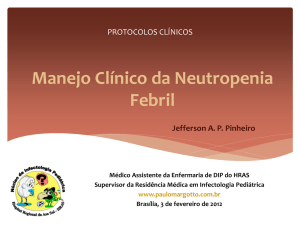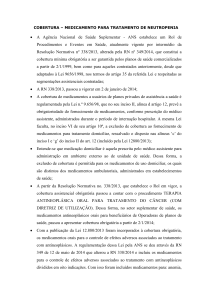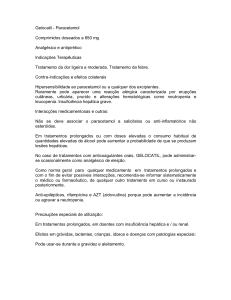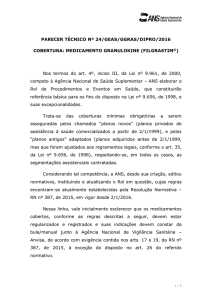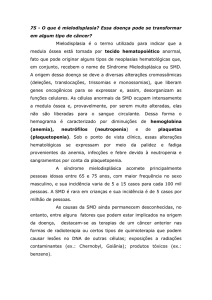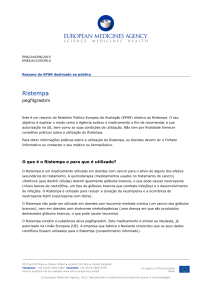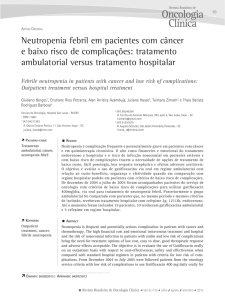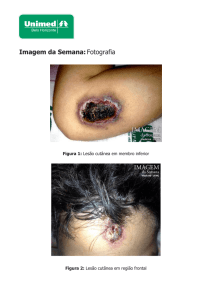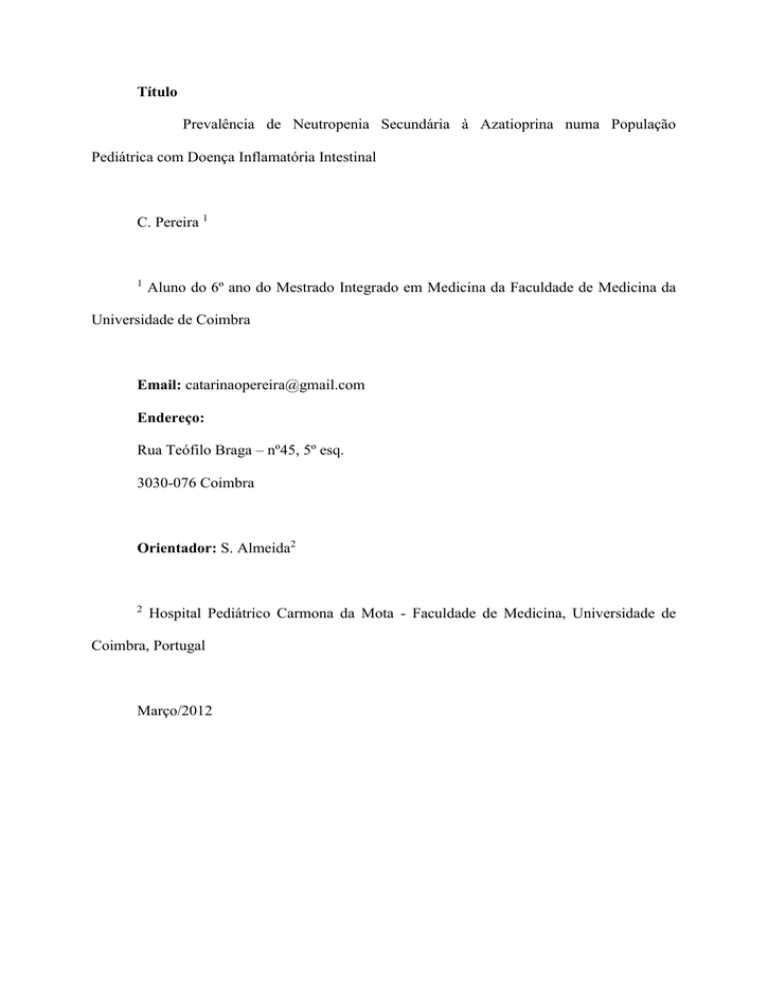
Título
Prevalência de Neutropenia Secundária à Azatioprina numa População
Pediátrica com Doença Inflamatória Intestinal
C. Pereira 1
1
Aluno do 6º ano do Mestrado Integrado em Medicina da Faculdade de Medicina da
Universidade de Coimbra
Email: [email protected]
Endereço:
Rua Teófilo Braga – nº45, 5º esq.
3030-076 Coimbra
Orientador: S. Almeida2
2
Hospital Pediátrico Carmona da Mota - Faculdade de Medicina, Universidade de
Coimbra, Portugal
Março/2012
Resumo
Introdução:
A azatioprina é um fármaco imunossupressor utilizado na doença inflamatória
intestinal. Um dos efeitos secundários da azatioprina é a depressão da medula óssea, com
consequente neutropenia e predisposição a infecções, podendo motivar a redução ou mesmo
suspensão do fármaco. A monitorização hematológica regular é obrigatória nos doentes sob
tratamento com este fármaco. Contudo, faltam estudos no sentido de avaliar factores de risco
para a ocorrência de neutropenia e a vantagem da realização do doseamento da actividade da
enzima tiopurina metiltransferase antes do início do tratamento, podendo ajudar a distinguir
os doentes com maior risco de depressão medular.
Objectivos:
Estudo retrospectivo, com o objectivo principal de avaliar a prevalência de leucopenia
e neutropenia como efeito secundário da azatioprina na doença inflamatória intestinal. Como
segundo objectivo, pretendeu-se avaliar o custo benefício da genotipagem da enzima tiopurina
metiltransferase em função da prevalência e gravidade dos casos de leucopenia e neutropenia
encontrados.
Metodologia:
Análise dos processos clínicos dos doentes com o diagnóstico confirmado de doença
inflamatória intestinal em tratamento com azatioprina, seguidos em consulta de
Gastroenterologia no Hospital Pediátrico de Coimbra. As variáveis analisadas foram: sexo,
idade, tipo de doença inflamatória intestinal, medicações concomitantes, dose, tempo de
tratamento com o fármaco e número de leucócitos e neutrófilos em hemogramas seriados. Foi
utilizado o programa Excel para o Windows 2003.
Resultados:
Nos 31 doentes estudados, a prevalência de casos de leucopenia foi de 8 (25,8%) e de
neutropenia foi de 7 (22,6%), (5 raparigas e 2 rapazes). Não se registaram neutropenias
severas.
A dose média do fármaco administrada nos doentes que desenvolveram neutropenia
foi 1,89 mg/kg/dia e a mediana foi de 1,8 mg/kg/dia.
Até à ocorrência de neutropenia o tratamento teve uma duração média de 10 meses,
com desvio padrão de 7,7 meses, mediana de 7 meses e amplitude interquartil de 5,5 meses.
Todos os doentes recuperaram os valores hematológicos com redução ou suspensão do
fármaco.
Conclusões:
A prevalência de casos de neutropenia obtida na nossa série foi elevada, sendo a
maioria em doentes do sexo feminino. O tempo de duração de tratamento até ao
desenvolvimento do efeito adverso foi muito variável, desde 5 meses até 27 meses. Todos os
casos encontrados foram de gravidade ligeira e reversível com a redução ou suspensão do
fármaco. A determinação da actividade da enzima tiopurina metiltransferase ou o estudo
molecular, não seria, no nosso caso, vantajosa em termos de custo/benefício.
Palavras-chaves:
Azatioprina, 6-mercaptopurina, tiopurinas, doença inflamatória intestinal, leucopenia,
neutropenia, tiopurina metiltransferase.
Abstract
Introduction:
Azathioprine is an immunosuppressive drug used in inflammatory bowel disease.
One of the side effects of azathioprine is bone marrow depression, which results in
neutropenia and susceptibility to infections, and this may encourage the reduction or
suspension of the drug. The regular hematological monitoring is mandatory in patients
receiving this drug. However, there are few studies assessing the risk factors associated with
the occurrence of neutropenia and the advantage of performing the dosage of enzyme
thiopurine methyltransferase activity before the beginning of the treatment, which could help
distinguish patients with increased risk of bone marrow depression.
Objective:
Retrospective study, with the main objective being the assessment of the prevalence of
leukopenia and neutropenia as a side effect of azathioprine in inflammatory bowel
disease. The
second
objective
is
to evaluate
the
cost benefit
of the
enzyme thiopurine methyltransferase genotyping based on the prevalence and severity of
cases of leukopenia and neutropenia.
Methods:
Analysis of clinical files of patients with confirmed diagnosis of inflammatory bowel
disease treated with azathioprine, followed in an outpatient appointment of Gastroenterology
in Coimbra Pediatric Hospital. The variables analyzed were gender, age, type of inflammatory
bowel
disease, concomitant
medications,
dosage
and duration
of
treatment
with
azathioprine, and the number of leukocytes and neutrophils in regular blood count. Excel for
Windows 2003 was used for statistical proposes.
Results:
In the 31 patients studied, the prevalence of leukopenia was 8 (25.8%) and 7 of those
had neutropenia (22.6%), (five girls and two boys). There were no cases of severe
neutropenia.
The mean
dose of
drug administered to
patients who developed neutropenia
was 1,89 mg/kg/day and the median was 1,8 mg/kg/day.
Until the occurrence of neutropenia, the treatment had a mean duration of 10 months,
with standard deviation of 7,7 months, median of 7 months and inter-quartile range of 5,5
months.
All patients recovered hematological indices with reduction or discontinuation of the
drug.
Conclusion:
The prevalence of neutropenia cases identified in our series was high, and occurred
mostly in female patients. The duration of the treatment until the development of the adverse
effect varied widely, namely from 5 months to 27 months. All observed cases were of mild
severity and reversible upon a reduction or suspension of the drug. The determination of
enzyme thiopurine methyltransferase activity
or molecular
analysis
wasn’t, in
our
case, advantageous in terms of cost/benefit.
Key words:
Azathioprine, 6-mercaptopurine, thiopurine, inflammatory bowel disease, leucopenia,
neutropenia, thiopurine methyltransferase.

